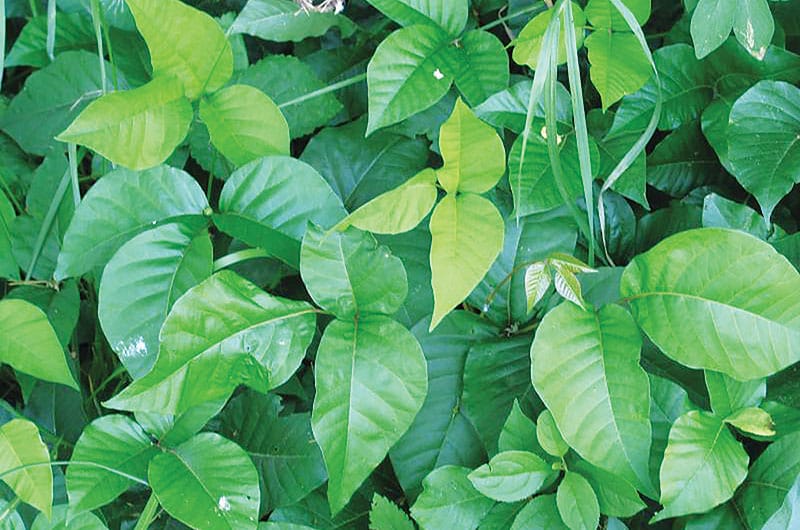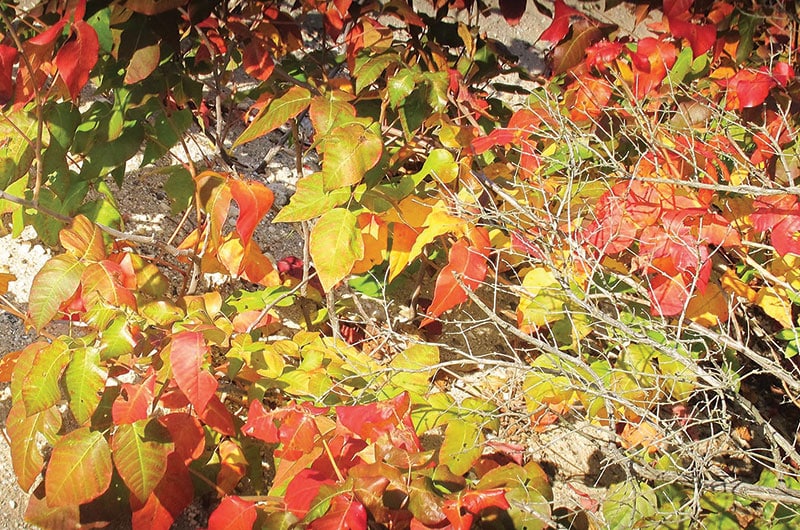by Sarah Treanor Bois, Director of Research & Education for the Linda Loring Nature Foundation

Poison Ivy is a plant I love to hate or hate to love. I am extremely allergic to it myself, but I marvel at its ability to morph into many plant forms. As a woody vine it climbs and girdles trees, as can be seen along the edge of the Nantucket State Forest. It can appear herbaceous, growing among the low bush blueberries and wildflowers of summer. Each stem seems to know how tall to grow to mimic the surrounding plants. It can be shrubby in nature, growing in and among the bayberries and huckleberries and growing no more than hip height. Making sure to cover all of its bases, I have even see poison ivy looking like a tree, though this has been exclusively in saltmarshes. Despite being a master of disguise, there are some tell-tale clues to identify it so you can avoid contact.
The first step in avoiding a rash is to know how to identify poison ivy. “Leaves of three, let it be,” is the old adage that works most of the time. While many native, innocuous plants have clusters of three leaves, it may be best to avoid all “leaves of three” if you’re not sure. Unlike some plants in the blackberry family with three leaves, poison ivy does not have thorns and generally has smooth leaf edges, though sometimes it is “variable toothed.” That basically means it does what it wants when it wants. Leaves are generally shiny, though not always, especially when along one of Nantucket’s many dirt roads. Want to test your detection skills? You can look at a poison ivy quiz at the following website: www.poison-ivy.org/poison-ivy-quiz.
If you do get into some poison ivy, here are some tips for washing yourself up ASAP:
- Before the urushiol has been absorbed by the skin, it can be removed with soap and water. Time is of the essence, as 50% of the urushiol can be absorbed within 10 minutes
- Use a good soap. This can be an ivy-specific soap like Technu or just something that cuts grease. We sometimes use Dawn dish soap in our house.
- Make sure to scrub/rub with the soap. This should be for about 1 minute without additional water.
- Rinse thoroughly. The hotter the water the better. Think about bacon grease and how much you need to scrub and wash before it’s off your hands.

I’m itchy just thinking about it.
Looks like we all have one more reason to fret about climate change. At least the birds will be happy.
A few poison ivy fun facts to help us hate it a little less.
- Poison ivy fruits are plentiful in late summer early fall. They are an important food source for birds and wildlife like white-tailed deer. Deer even graze on the twigs and leaves!
- Deer, dogs, and other Nantucket fauna are not allergic to urushiol oil.
- Research has shown that poison ivy is tolerant of wastewater, indicating it may be a good plant to treat sewage.
- In the fall, poison ivy leaves turn a brilliant crimson color. Driving down the Milestone Road, it brings some bright colors to the evergreen pines of the state forest.


